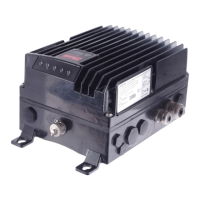23
All tests will be made with an ohmmeter capable of testing diodes. Use
a digital VOM set on diode scale or an analog ohm meter set on RX100
scale. Before making any checks disconnect all input power, motor
and brake option connections.
CAUTION: Allow sufficient time for the DC Bus to fully discharge
before beginning testing. The presence of bus voltage can be
tested by setting your voltmeter for 500VDC and reading the
terminals labeled 88 (–) and 89 (+).
The purpose of statically testing the soft charge circuit is to rule out
failures of the Soft Charge Rectifier and Soft Charge Resistors. If the
soft charge fuses have blown, it indicates the possibility of a short circuit
of the DC Bus. A DC Bus short can be caused by:
Two shorted IGBT's--one negative and one positive in
the same phase
A shorted Brake Module IGBT or having connected the
Brake Module incorrectly
Shorted DC Bus capacitors
These are the primary causes; however, any component which is
connected across the positive and negative bus if shorted can result in
a DC Bus short. Conducting the remaining Static Test Procedures
should rule out the remaining possibilities.
SECTION THREE
STATIC TEST
PROCEDURES
TESTING THE
SOFT CHARGE CIRCUIT

